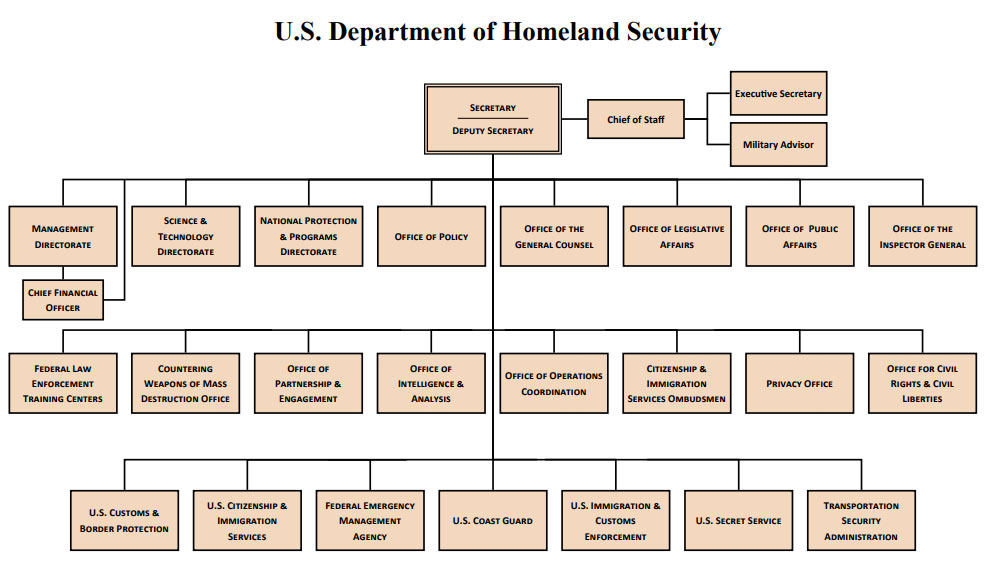Federal Agencies: Department of Homeland Security
The U.S. Department of Homeland Security (DHS) of the United States is a combination of 22 different agencies that employ more than 200,000 people.

DHS organizational chart, Dec. 2017, Source: dhs.gov
The goals of the DHS are very clear. The department must:
- Guard against terrorism
- This is considered the founding principle of the Department and its highest priority.
- Resources available are put towards prevention and preparedness at a military level and as a nation, efforts are directed to keeping Americans informed on how to live in a constant state of readiness for a potential threat.
- Secure U.S. borders
- Every year the DHS' agencies in charge of U.S. border patrol and customs enforcement apprehend and deport more than one million illegal immigrants, deterring countless more from trying to cross the Southern border, the Northern border and the U.S. air and sea ports illegally.
- Since the early 2010s, the DHS has been working on several initiatives to strengthen security on the Southwest border to stop the flow of the drug, cash and weapon smuggling that keep the Mexican drug cartels in power.
- Enforce U.S. immigration laws
- The agency works to facilitate legal immigration while putting a stop to those who violate the U.S. immigration laws -- in particular, criminal illegal aliens and employers who knowingly hire illegal workers.
- Improve the country's readiness for, response to, and recovery from disasters
- The DHS plays an important role in helping communities in all stages of a disaster, such as hurricanes, tornadoes, floods, but also any health-related issues of national importance, such as the H1N1 flu back in the late 2000s
- The department must coordinate the preparation, response and long-term recovery in the region of the country affected.
Creation of the U.S. Department of Homeland Security
Prior to the establishment of the DHS, all of the current homeland security activities were spread across more than 40 federal agencies.
In early 2001, the U.S. Commission for National Security had proposed changes throughout the executive and legislative branches and a bill eventually circulated advocating for the creation of a homeland security agency. The bill attempted to combine into one The Federal Emergency Management Agency, FEMA, Customs & Border Patrol (CBP), and other agencies in charge of homeland-security related activities. There were hearings related to the matter, but Congress took no further action on this bill.
Later on, in that very same year, however, the United States was forced to look more closely into how to organize and focus its homeland security efforts. The attack on the Twin Towers in New York City on September 11, 2001, became the real catalyst for the formation of the DHS, the biggest U.S. government reorganization in American history.
Just 11 days after the attacks, President George W. Bush announced the creation of the Office of Homeland Security. The new office would focus on overseeing and coordinating a national strategy to protect the country from terrorism and any future attacks.
The DHS was then officially established in 2002, the next year, with the passage of the Homeland Security Act by Congress. The Department of Homeland Security formally came into being as a stand-alone, Cabinet-level department. It began its functions on March 1, 2003.
References:
"Our Mission" from DHS.gov
"Creation of the Department of Homeland Security" from DHS.gov
"The Department's Five Responsibilities" from DHS.gov
"The Department of Homeland Security: Background and Challenges" from The National Academies Press
"Brief Documentary History of the Department of Homeland Security 2001 - 2008" from Department of Homeland Security via Aila.org
